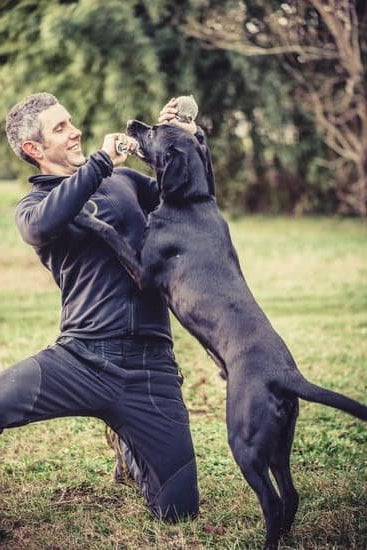Are you wondering how to kennel train a small dog? Kennel training, also known as crate training, can be a valuable tool for pet owners when it comes to providing safety, security, and comfort for their small dogs. In this article, we will explore the fundamentals of kennel training for small dogs and provide you with practical tips and guidance on how to successfully introduce your furry friend to their new space.
When it comes to kennel training a small dog, choosing the right kennel is crucial. We will discuss important factors such as size and materials to consider, as well as the difference between crate training and basic kennel training methods. Setting up the kennel in your home is another critical step in the process. We will provide tips on ideal locations and placement considerations, as well as how to make the space cozy and comfortable for your small dog.
Getting your small dog used to the kennel is an essential part of the training process. We will delve into gradual introduction techniques and positive reinforcement methods, including using treats and toys to create a positive association with the kennel. Additionally, we will cover how to establish a consistent kennel training schedule and address common challenges and resistance that may arise during this training process.
Choosing the Right Kennel for Your Small Dog
When it comes to kennel training a small dog, choosing the right kennel is crucial for the success of the training process. The first thing to consider when selecting a kennel for your small dog is the size.
You want to ensure that the kennel is large enough for your dog to stand up, turn around, and lie down comfortably. It should not be too big as this may lead to accidents inside the kennel if your dog decides to relieve themselves in one corner and sleep in another.
The materials of the kennel are also an important factor to consider. For small dogs, plastic or wire crates are commonly used. Plastic crates can provide a cozy, den-like environment for your small dog, while wire crates offer more visibility and ventilation.
The choice between crate training versus basic kennel training should also be considered. Crate training involves using a crate or kennel as a tool for housebreaking and providing your dog with a safe space, while basic kennel training focuses on getting your dog comfortable with spending time in their designated area.
Ensuring that you choose the right size and materials for your small dog’s kennel is essential in creating a comfortable and safe space for them. Additionally, considering whether crate training or basic kennel training best fits your goals will help set the stage for successful kennel training.
| Aspect | Considerations |
|---|---|
| Size | Large enough for comfort but not too big |
| Materials | Plastic vs. wire crates |
| Crate Training vs Basic Kennel Training | Different goals and uses of each method |
Setting Up the Kennel in Your Home
Choosing the perfect kennel for your small dog is only the first step. You also need to set it up in a way that makes your furry friend feel safe and comfortable. Here are some tips for creating the perfect space for your small dog:
When setting up your small dog’s kennel, it’s important to consider where to place it in your home. Choose a quiet and calm area where your dog can retreat to for some peace and quiet. Avoid high-traffic areas or places with lots of noise and activity. This will help create a safe haven for your small dog, especially during moments of anxiety or stress.
Making the Kennel a Comfortable and Cozy Space
To make the kennel inviting for your small dog, consider adding soft bedding or blankets inside. This will provide a cozy spot for them to rest and relax. Additionally, you can add some of their favorite toys or treats inside the kennel to make it feel like a positive space. It’s important to create an environment where they feel secure and at ease.
Creating an inviting atmosphere within the kennel can help make the training process more successful. It’s essential that your small dog associates their kennel with comfort rather than punishment.
Examples of Cozy Additions
Consider adding a soft blanket or cushion to make the floor more comfortable.
Place some of your dog’s favorite toys or treats inside the kennel as positive reinforcement.
Create a calming atmosphere by using pheromone sprays or plug-ins designed specifically for dogs.
Remember, every small dog is different, so be patient as you discover what works best for your furry friend when setting up their personal space within your home.
By following these tips, you can ensure that your small dog’s kennel becomes their happy place-a spot they willingly enter whenever needed-thanks to careful setup and consideration of its design.
Getting Your Small Dog Used to the Kennel
When it comes to kennel training a small dog, getting your furry friend comfortable with their new space is crucial for successful training. Here are some tips on how to help your small dog adjust to their kennel:
- Gradual introduction and positive reinforcement: Start by introducing your small dog to the kennel in short increments of time. Encourage them to explore the space on their own terms, and always use positive reinforcement such as treats and praise when they willingly enter the kennel.
- Using treats and toys to create a positive association with the kennel: Place your small dog’s favorite treats or toys inside the kennel to entice them to enter. This will help them associate the kennel with positive experiences, making it a more inviting space for them.
- Consistency and routine for successful training: Establishing a consistent schedule for using the kennel can help your small dog get used to the routine. Incorporate short periods of kennel time into their daily schedule, gradually increasing the duration as they become more comfortable with being in the kennel.
Overall, patience and persistence are key when getting your small dog used to their kennel. It’s important not to rush the process and allow them to acclimate at their own pace. With time and positive reinforcement, most small dogs can learn to see their kennel as a safe and comfortable space.
Creating a Kennel Training Schedule
Consistency and Routine for Successful Training
When it comes to kennel training a small dog, consistency and routine are key factors in achieving success. Establishing a schedule for kennel time can help your dog acclimate to the space and understand expectations.
It’s important to set specific times for when your small dog should be in the kennel, such as during meal times or at bedtime. Additionally, ensuring that the duration of kennel time is consistent from day to day will help your dog feel secure and less anxious about being in the crate.
How to Incorporate Kennel Time Into Your Daily Routine
Incorporating kennel time into your daily routine can be done by integrating it seamlessly with your existing schedule. For example, if you typically go for a walk with your small dog in the morning, consider placing them in the kennel for a short period upon returning home. This allows them to associate their kennel time with the routine of going out for walks.
It’s also important to maintain a regular feeding schedule and use the kennel as part of mealtime routines. By consistently incorporating kennel time into your daily activities, your small dog will learn to see it as a natural part of their day.
Maintaining Patience and Persistence
While establishing a kennel training schedule, it’s crucial to maintain patience and persistence throughout the process. Some small dogs may resist being in the kennel initially, but with consistent training and positive reinforcement, they can learn to feel comfortable and secure in their space. It’s essential to remain patient and avoid forcing your dog into the crate, as this can create negative associations with the space.
Instead, persistently work on creating positive experiences within the kennel through treats, toys, and praise. With time and dedication to your training schedule, you can successfully kennel train your small dog.
Dealing With Challenges and Resistance
Kennel training a small dog can be a rewarding experience, but it also comes with its own set of challenges and resistance. It is essential to address these issues with patience and persistence to ensure successful kennel training for your small dog.
One common challenge when kennel training a small dog is separation anxiety. Dogs are social animals, and being left alone in a kennel can cause distress for some pets. To address this, it’s important to gradually introduce the concept of alone time in the kennel.
Start with short periods of time and gradually increase it as your small dog becomes more comfortable. Positive reinforcement, such as treats or toys, can also help create a positive association with the kennel and reduce anxiety.
Another common source of resistance when kennel training a small dog is behavioral issues such as whining or barking in the kennel. This behavior can be challenging for both the dog owner and their furry companion. Using positive reinforcement techniques, like offering rewards for quiet behavior in the kennel, can be an effective way to address this resistance.
It’s important not to inadvertently reinforce negative behaviors by giving in to your dog’s demands when they whine or bark. Consistency is key to overcoming these challenges.
Additionally, some small dogs may display stubbornness or reluctance when it comes to entering their kennels. This type of resistance could be due to fear or discomfort about being confined in there as well as a sense of loss of freedom if they feel that they are being punished for some reason. Offering enticing treats, cozy bedding, and comforting toys inside the kennel can make it a more appealing and inviting space for your small pooch.
Understanding how to identify these challenges and having strategies in place on how to overcome them will lead you toward successfully crate-training your little furball.
| Common Challenge | How to Address |
|---|---|
| Separation Anxiety | Gradually introduce alone time; use positive reinforcement |
| Barking/Whining | Reinforce quiet behavior with rewards; stay consistent |
| Stubbornness/Reluctance | Make the kennel inviting with treats, bedding, toys; take gradual steps |
Using the Kennel for Potty Training
When it comes to kennel training a small dog, using the kennel for potty training can be an effective tool in teaching your furry friend where and when to go to the bathroom. Here are some tips for utilizing the kennel in the potty training process:
- Establishing a routine: One of the key elements of successful potty training with a kennel is establishing a consistent routine for potty breaks and kennel time. This means taking your small dog outside to the designated potty area at regular intervals throughout the day, as well as after meals, playtime, and naps.
- Using the kennel as a tool: When you cannot directly supervise your small dog, placing them in their kennel can prevent accidents inside the house. Dogs generally will not eliminate in their sleeping area, so using the kennel as a temporary confinement during times when you cannot closely monitor your pet can help reinforce good potty habits.
- Positive reinforcement: As with any aspect of kennel training, positive reinforcement is key. When your small dog successfully goes to the bathroom outside after being let out of their kennel, be sure to praise and reward them with treats or toys. This will help create a positive association with going to the bathroom in the appropriate place.
By incorporating these tips into your kennel training routine, you can use the kennel as an effective tool for potty training your small dog. Remember that patience and consistency are essential when it comes to any type of dog training, including potty training.
Gradually Increasing Kennel Time
As your small dog becomes more comfortable with their kennel, it’s important to gradually increase the amount of time they spend in it. This process should be done slowly and with patience to ensure that your pup feels secure and at ease in their new space.
Start by leaving your small dog in their kennel for short periods of time while you are home. This will help them get used to being alone in the kennel without feeling anxious or fearful.
Once your dog seems relaxed and content spending short amounts of time in their kennel, you can begin to leave them in it for longer periods. It’s essential to monitor your pet’s behavior during these times and make adjustments as needed. It’s also a good idea to provide your small dog with toys or treats to keep them occupied and make the experience positive.
Some dogs may need more time to adjust than others, so it’s crucial to pay attention to your pet’s individual needs and comfort level. If at any point your dog seems distressed or anxious about being in the kennel, go back a step and take things slower.
Gradually increasing the amount of time your small dog spends in their kennel will not only help with potty training but also create a safe haven for them when you’re away from home.
Remember that every small dog is unique, and how to kennel train a small dog will require adaptability on your part. With patience, consistency, and lots of positive reinforcement, you can successfully transition your furry friend into spending extended periods in their kennel.
Troubleshooting and Additional Tips
If you are struggling with kennel training your small dog, you are not alone. Many pet owners face challenges and resistance when it comes to getting their furry friends comfortable with the idea of being confined to a kennel. However, with patience, persistence, and the right techniques, it is possible to successfully kennel train your small dog.
One common challenge that many pet owners face is separation anxiety in their small dogs. This can make kennel training particularly difficult, as your dog may become stressed or anxious when left alone in the kennel. To address this issue, it’s important to gradually introduce your dog to the kennel and create a positive association with being inside it.
You can achieve this by using treats and toys as rewards for entering the kennel and spending time in there. It’s also helpful to start with short periods of time in the kennel and gradually increase the duration as your dog becomes more comfortable.
Another common issue that pet owners may encounter during kennel training is behavioral problems such as barking or whining while inside the crate. This can be frustrating for both you and your dog, but it’s important to remain patient and consistent in addressing these behaviors.
One effective strategy is to ignore any attention-seeking behavior while your dog is in the crate and only provide positive reinforcement when they are calm and quiet. It’s also crucial not to use the kennel as punishment, as this can create negative associations and make training even more challenging.
In addition to troubleshooting specific challenges during kennel training, there are also some additional tips that can help make the process smoother for both you and your small dog. For example, providing plenty of exercise and mental stimulation outside of crate time can help reduce anxiety and restlessness when it’s time for your dog to be confined.
Additionally, seeking support from professional trainers or behaviorists can offer valuable guidance tailored to your specific situation if you find yourself feeling stuck or overwhelmed with the process of kennel training a small dog at home.
Remember that every small dog is unique, so it’s essential to be patient, adaptable, and attentive throughout the entire process of kennel training – from initial introduction all the way through gradual increases in kennel time. With consistency, routine, positive reinforcement, and a little bit of troubleshooting along the way, you can ensure that your furry friend becomes well-adjusted to their new routine within a cozy space they come to love dearly.
Conclusion and Celebrating Success
In conclusion, kennel training a small dog can be a rewarding and beneficial experience for both the pet and the owner. It provides a safe and comfortable space for the dog while also aiding in housebreaking and behavior management. By following the tips and guidelines outlined in this article, you can successfully introduce your small dog to kennel training and create a positive association with their crate or kennel.
Remember that patience and consistency are key when it comes to kennel training a small dog. It is important to gradually introduce them to the kennel, using positive reinforcement such as treats and toys to create a sense of comfort and security. Additionally, establishing a routine for potty breaks and kennel time will aid in successful housebreaking.
As you embark on this journey of kennel training your small dog, keep in mind that every dog is unique and may require different approaches. Be prepared to address challenges or resistance with patience and persistence. And most importantly, celebrate the progress and achievements along the way. With time and dedication, your small dog can become well-trained and comfortable in their kennel.
Frequently Asked Questions
How Do You Crate Train a Tiny Dog?
Crate training a tiny dog involves introducing the crate as a positive and safe space, gradually getting the dog comfortable with being inside it, and using rewards and positive reinforcement to encourage the dog to enter and stay in the crate.
How Long Does It Take to Train a Dog to Be in a Kennel?
The time it takes to train a dog to be in a kennel can vary depending on the individual dog’s temperament, previous experiences with confinement, and the consistency of the training. It may take anywhere from a few days to a few weeks for a dog to become comfortable being in a kennel.
Will a Dog Cry if a Crate Is Too Small?
A dog may cry if it’s too small. If a crate is too small for a dog, they may feel cramped and uncomfortable, leading them to whine or cry in an attempt to express their discomfort. It’s important to ensure that the crate is appropriately sized for the dog’s comfort and well-being.

Welcome to the blog! I am a professional dog trainer and have been working with dogs for many years. In this blog, I will be discussing various topics related to dog training, including tips, tricks, and advice. I hope you find this information helpful and informative. Thanks for reading!





